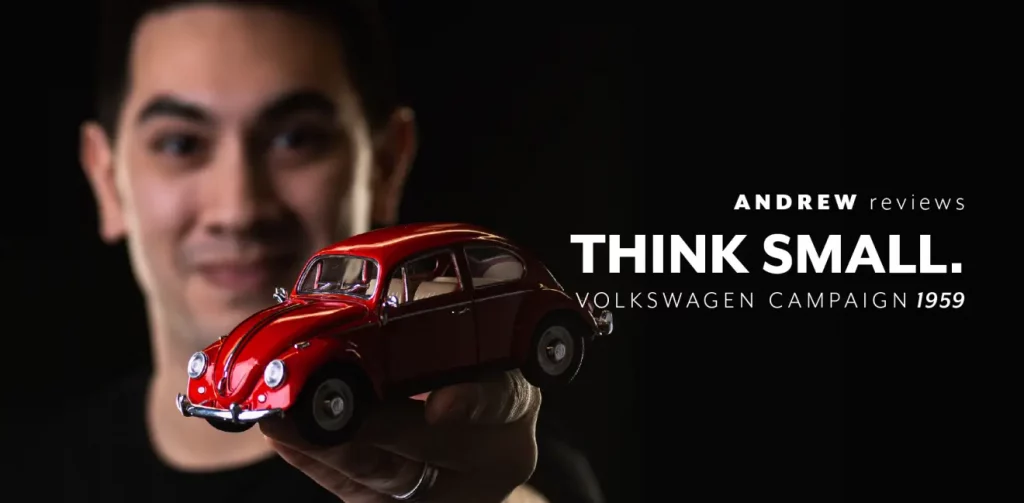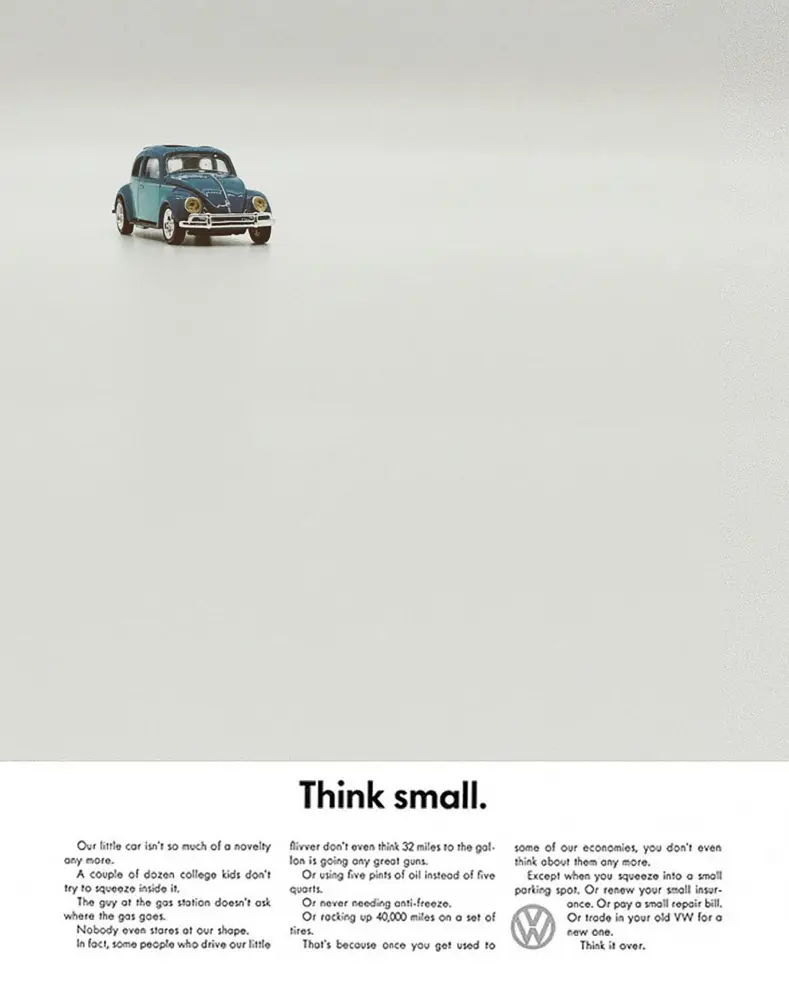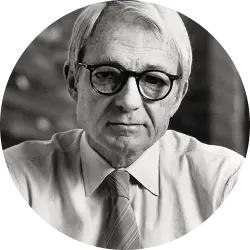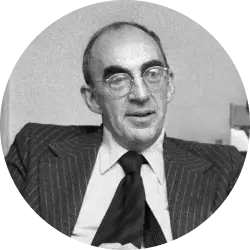- 701-532-0576
- andrew@teamabovo.com
- 218 Broadway, Fargo ND 58102


Many marketing and advertising professionals define Volkswagen’s “Think Small” campaign as the gold standard and it still influences much of the marketing we consumers see today. This is the ad campaign that arguably, set the bar for copywriters and print advertising, and set it high.

The Volkswagen Beetle is one of the highest-selling vehicles worldwide and it was designed by Ferdinand Porsche.
Entering the American market in the 1950s/60s was a massive challenge for Volkswagen. Put yourself in their shoes during this time:
1. They are trying to penetrate the American market post World War II, fighting negative perceptions of being a German company.
2. Their product line-up is all small vehicles, and American consumers wanted big American cars with big engines. How many of you reading this remember the Chevy Bel Air and the Cadillac El Dorado? These incredible challenges sparked the Volkswagen Group to reach out to a USA advertising firm, Doyle Dane & Bernbach (DDB). Knowing their challenges, DDB set out to answer one question: How can we change peoples’ perceptions not only about a product but also about an entire group of people (Germans)? Knowing Volkswagen couldn’t compete with the (literally) larger vehicles, DDB decided to embrace the Volkswagen Beetle for what it was and sell the concept of an
“honest, odd, little car.” DDB assigned a creative director (Helmut Krone) and copywriter (Julian Koenig) who decided they would play into what Americans were saying and thinking about the Beetle. They looked at the VW Beetle for what it was. Small. Ugly. Affordable. They took these traits and weaknesses and turned them into strengths; differentiators. And right at the top of the first
rendition of the soon-to-be-iconic campaign, they showcased the biggest, most widespread criticism of the car: Its size.
“Think Small” rolled out in 1959, with zero expectations from Volkswagen – “It can’t get worse,” they thought. The results of the campaign were almost instantaneous, resulting in immense success. People all over the US, and the world, were talking about it. Sales backed up the campaign, and Volkswagen reached enormous success in the United States within only a few years, rivaling giants like Ford, Chevrolet and Cadillac. To this day, it’s still considered the greatest ad campaign of all time.
1. It was the first ad campaign ever to embrace criticism and pivot it into positive messaging, breaking the fourth wall between the brand and its audience. It was openly self-deprecating in a way that became endearing.
2. It embodied its message wholly. One example is the juxtaposition of a small car with the “Think Small” tagline, but an even better example is that the ad was printed in black and white when color ads were the industry standard. Americans saw Volkswagen as a cheap, inferior brand and printing
the ad in black and white was another way for the brand to be honest with itself and embrace the messaging.
3. The simplicity of the ad gave it power. Other ads at the time featured loud pictures, massive amounts of copy and distracting layouts. Volkswagen’s ad was simple, organized, uncomplicated and digestible, giving the consumer a break from the clutter.


There is a story that says Helmut Krone, the creative director of VW’s “Think
Small” campaign, actually left the country before the rollout, fearing he’d be ridiculed for how terrible it was.

We all celebrate Julian Koenig every year (kind of). Mr. Koenig was also responsible for coming up with “Earth Day.” The first Earth Day event was held on April 22nd (the date it’s still celebrated today) in honor of Mr. Koenig as it’s also his birthday.
To this day, more than 60 years later, Volkswagen still uses a similar ad layout. Grab any Volkswagen ad, and you’ll see a striking resemblance: An image covering 3/4 of the page and ad copy at the bottom on the remaining 1/4, most likely set in three columns. If you look closely, copywriting hasn’t changed much either. Short sentences, structured in tiny paragraphs. Snappy, tight taglines. A conversational tone.
The most impressive takeaway from the campaign is its influence on how almost every brand advertises, even today. Think of some of your favorite or large brands like Apple or McDonald’s. The format of their ads illustrates the movement created by Volkswagen’s iconic campaign. Don’t try to sell your company, product or service as something it’s not.
Volkswagen has a history and tradition of naming their vehicles after oceanic currents or natural phenomenon that occur within the oceans. Examples: Jetta, Corrado, Vento, Passat, Santana and Scirocco.
They recognize and appreciate honesty. “Think Small” taught us how truly valuable (and vital) creativity is in the advertising process and how sometimes it’s best to simply “Think Small.”

SOURCES
“20 facts few people know about Volkswagen.” Hotcars.com, April 2018.
“What Volkswagen’s ’Think Small’ campaign teaches copywriters.” San Francisco School of Copywriting, 2021.
“Volkswagen – statistics and facts.” Statista, October 2021.
“Earth Day – the roots of the name remembering Julian Koenig.” EarthDay.org, April 2014.
“The ad that changed advertising.” Medium.com.

Allyson reviews The Man Your Man Could Smell Like Oldspice Campaign – 2010
Jennifer reviews The Energizer Bunny Energizer Campaign – 1989
Tristan reveiws The Moldy Burger Burger King Campaign – 2020
Kristen reviews A Diamond is Forever DeBeers Campaign – 1938
Jack reviews You’re Not You When You’re Hungry Snickers Campaign – 2010
Jonathan reviews “WHASSUP?!” Budweiser Campaign – 1999
© All rights reserved by ABOVO | Fargo North Dakota | Privacy Policy | Terms of Service